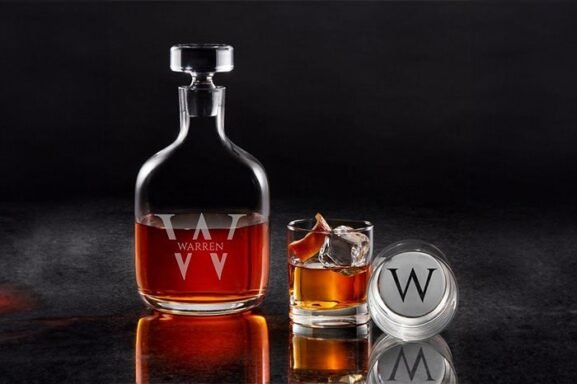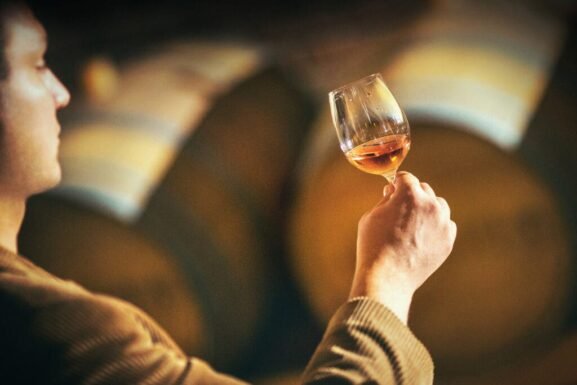‘The Gentlemen’ Features an Unusual Decanting Method. Is It Any Good?
Guy Ritchie’s new Netflix action series The Gentlemen, a spin-off of his 2019 film of the same name, has a tendency to make everything, even crime, seem luxurious. When second-born son Edward Horniman (played by Theo James) unexpectedly inherits his father’s stunning estate, duke title and lucrative underground weed operation, he also gains access to a large wine cellar that holds hundreds of thousands of pounds worth of rare wines. Throughout the first episode, Horniman always seems to have a glass of red within grabbing distance.
You May Also Like: The Iconic Burgundy Wines You’ll Probably Never Taste
The new Duke of Halstead soon learns that a mysterious millionaire, Stanley Johnston (played by Giancarlo Esposito), wants to pay an exorbitant amount, well above market value, for the centuries-old estate. When they meet, in a sleek private study lined with leather-bound books, Johnston’s associate begins an elaborate process for serving them wine. “I hope you don’t disapprove of the way I prefer my wine presented, in breaking with tradition,” Johnston says.
We then see a comically over-the-top process: The associate swirls the bottle of red wine, which we learn is a rare and expensive 2002 Domaine de la Romanée-Conti (i.e. DRC). He opens the bottle, pours the wine through a coffee filter and into a decanter, and rinses the bottle with water, to clear it of any sediment. Finally, he pours the wine back into the bottle “so it can be enjoyed in its original housing.”
The archetype of the wine snob has long provided comedic fodder in film and television, as well as an opportunity to satirize the excesses of the upper class. In The Gentlemen, the scene is a caricature of wine culture gone overboard. But we wondered: Does this lengthy (and overly pretentious) method of serving wine have any merit?
As a long-time Guy Ritchie fan, Noah Schulman, director of wine for RPM Italian Restaurants, was “elated” to spot the ’02 Romanée-Conti in the show, then cringed throughout the rest of the scene. Here’s what went wrong: “First the foil was cut incorrectly too high on the neck of the bottle, opening up risks in altering the $40,000 wine by coming into contact with the wine as it’s poured,” Schulman says. “Next, water has a different pH level than wine and should never be used to clean the empty bottle, posing another threat at changing the wine’s character.”
To Schulman, however, the coffee filter was the most unforgivable offense: “The act of straining a mature Grand Cru Burgundy of this quality through a coffee filter struck me as sacrilege.”
Without the filter, the technique is known as double decanting, says Danya Degen, wine director at Méli in Washington D.C. While the process “isn’t necessary at all,” Degen finds it to be quite helpful in certain situations.
“It’s a go-to of mine, especially when I’m hosting guests and want to quickly get a younger red ready to drink,” she says. “I jump to this method when opening youthful wines made in tannic styles like elegant Cabs and Cab blends, premium Tempranillos, like those from Ribera del Duero, and my favorite wine to double decant: Barolo. It’s a neat trick to open up recent vintages while keeping the label, the artist’s signature, on display.”
Employing the filter, however, is pure excess, because “careful double decanting with a bottle rinse should remove all the big pieces of sediment from the wine,” she says.
Degen points out that an aged Pinot Noir like the DRC served in The Gentlemen should never be double decanted. “Lighter-bodied wines have nuanced fruit, delicate aromatics and flavors,” she says. “The fruit will fade as the wine ages, and this process is further expedited once the bottle is opened. Aerating it further will result in no fruit left.”
You May Also Like: How to Clean a Wine Decanter, According to Professionals
Liz Combs, general manager and sommelier at Dario in Minneapolis, also suggests skipping the coffee filter. “There’s already plenty of pomp and circumstance around decanting a wine,” she says. Another step she would forgo? Rinsing the original bottle with water. “Serving a special wine from the bottle is a lovely idea after it’s had some time in the decanter,” Combs says, “but adding any amount of water to the mix will water down the wine! Don’t fear a little sediment. It’s all part of the experience.”
According to Matthew Brodbine, beverage director at Santa Monica’s award-winning bistro Pasjoli, the show’s technique is mostly pretension.
“The only time I would decant through a coffee filter is if the wine had lots of sediment that was kicked up during the transportation process, like from someone’s cellar to the restaurant,” Brodbine says. “Usually, I am just very careful and decant using a candle, which is the normal, classic way of decanting. I have read some somms or at-home purists will decant three-quarters of the bottle then a quarter of the remainder through a coffee filter to maximize their return, which I can totally understand. But no one I know is pouring it back in the bottle.”
You May Also Like: The Best Wine Decanters for Every Occasion
Brodbine says he would not go through all that trouble, which may aerate the wine thoroughly, but “that’s what the decanter is for.” Also. cleaning the bottle with water could slightly dilute the wine, unless you allow it to fully dry before pouring the wine back in.
“Personally I am not into diluting my 2002 DRC, Romanée-Conti, or any wine for that matter,” says Bordbine. “It just seems like an ‘over-the-top-look-at-how-much-better-I-am-than-you’ moment for TV. Like putting your spirits in crystal decanters just because they look nicer. Maybe I am in the minority, but what do I know? I’m just a guy from New Hampshire.”
Published: April 9, 2024

